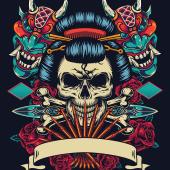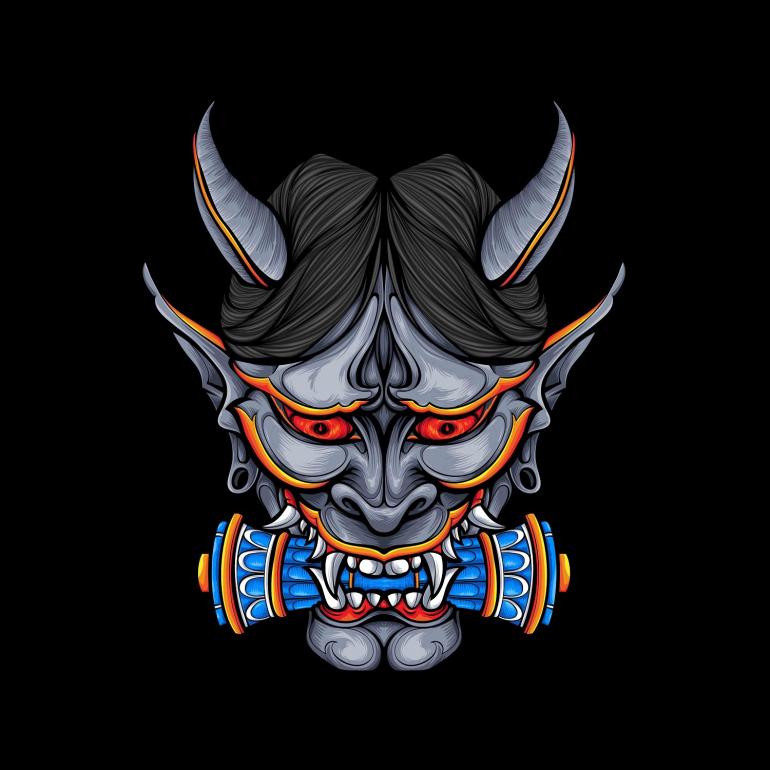Japanese Tattoos
The art of tattooing in Japan
The art of tattooing in Japan is called Irezumi (入れ墨, literally: inkjet). Japanese tattoos was started in the beginning by wood carving artists. Wood carving artisans mainly use the so-called Nara Squid, which is characterized by a deep black color. Tattoo artists in Japan are known as horishi (彫り師, wood carvers or tattoo artists). The needles are attached with silk threads to a long thin tube made of bamboo, metal or ivory. The skin is then stretched with one hand while the other hand controls the stick and continuously inserts the needle into the skin. Most artists use different sticks with the right number of needles for lines or fills and shading. Traditional artistic training takes several years, and students often adopt a name that includes the word Hori and part of their teacher's name. A typical full body tattoo usually lasts several years and is done by a single artist. There is a close relationship between the client and the tattoo artist. Unlike in Western worlds, the tattoo artist in Japan usually has a much more intense influence on the result. The first mention of Japanese tattoos is found in a 3rd century Chinese history. There are also early references to tattoos of the Ainu, the indigenous people of northern Japan. During the Kofun period, around 300-600 AD, Japanese tattoos were increasingly used to identify criminals. The obvious scars on their faces were intended to make it difficult for them to reintegrate into society.

Japanese Tattoos: The History of Japanese Tattoo Art from 16th to 18th Century
Japanese tattoos (Irezumi), literally meaning "sticking with ink," became a term used by the Japanese for this purpose in 1720. At that time, the ruling class set the tone for Japanese tattoos known as niju. Japanese tattoos were used at that time to mark a person who committed a crime with different symbols depending on the crime and the region. These markings ranged from simple lines around the forearm to Chinese characters (kanji) on the forehead. Serious criminals were thus easily identified. Irezumi does not refer to traditional tattoos as we know them today. In Japan today, the term can still have very negative connotations, depending on who you talk to. At the time, the Japanese had a negative attitude towards Japanese tattoos. The practice of tattooing in Japan has also developed in other social classes. Prostitutes in the red light district sometimes indulged in tattoo culture with their clients. The tattoo in this context is usually a simple black dot with which customers and prostitutes can form a kind of alliance. This is how these women gain loyal customers and keep the men coming back.
Japanese Tattoos: The History of Japanese Tattoo Art in 18th and 19th Century
In 1827, Japanese tattoo art reached a turning point in design and expression. At the beginning of the Meiji period in 1869, the Japanese government tried to improve the image of the country to make a better impression in the West and had tattoos banned. The method of punishment (bokkei), in which criminals were given a special stamp, was also abolished. Japanese tattoos were legalized in 1948, but the stigma was not removed. Most public baths, hot springs and gyms still do not allow tattoos. They are particularly associated with the criminal yakuza, and ironically, organizations have increasingly opted out of immigration in recent years in order to better integrate into society.
The so-called nyuju first appeared in Chinese writings, particularly in connection with the Ainu of Japan, who decorated their bodies with tattoo art. It is a beard pattern on the upper lip and a pattern between the hands and fingers. An Ainu woman's facial tattoos reveal her marital status and how many children she had. At that time, Japanese tattoos had a more social purpose. The beginning of the Meiji era ended Japan's access after the end of Sakoku (鎖国) (from 1633 to 1853). A time when the island was closed to the rest of the world. As Japan began to open up, the government was concerned about Japan's image in the world. In order to maintain Japan's image, the Japanese government decided to put an end to punishment (Irezumi) in 1870 and to ban Horimono in 1872, fearing that it would convey a barbaric image to the inhabitants of the West. This ban forced the Japanese to perform tattoos in secret. Even though the tattoo culture was marginalized, it did not completely disappear, and the Horimono culture remained intact among the passionate Japanese. After the passing of this law, horishi were forced to hide from the authorities under false names in order to continue their careers in peace. Ironically, on the other side of the world, foreigners, especially sailors, became interested in this new Japanese tattoo culture. Horimono's popularity eventually reached the British royal family when Prince George, later King George V. ,got a dragon and tiger horishi tattoo in Japan in 1881.
Japanese Tattoos: The History of Japanese Tattoo Art in the 20th Century
After World War II, Americans immigrated to Japan and ruled Japan for several years. A law passed under American pressure forced the Japanese government to lift the ban on Japanese tattoos in 1948. However, the negative image of tattoos in Japanese society remained. Every year, followers of Japanese tattoos gather at the Oyama Afuri Shrine (Oyama Afuri Shrine) on Mount Daisen between Mount Fuji and Tokyo in Kanagawa Prefecture. There, Choyukai members participate in religious ceremonies, bathe under waterfalls and show their tattoos to the gods before praying in the temple precincts. They wanted to retain the spiritual essence of the craft and its importance in Japanese culture and history. The transition to a more positive perception of tattoos happened very slowly in Japan.




Japanese tattoos: meaning and symbolism
These traditional tattoo designs not only have their own history, they also have their own meaning and cannot be chosen arbitrarily. Beautiful colorful koi, tigers that protect your arm and various Japanese flower tattoos accompany the wearers for the rest of your life. This also plays an important role, so the tattoo artist should also have the appropriate experience.
Japanese tattoos: how were and are Japanese tattoos stung
There are very few traditional tattoo artists in Japan who have mastered this ancient art of tattooing. The path to tattooing is long and painful, modern tattoo machines are not used, but traditional manual tools. A bundle of needles (tebori sticks) attached to a bamboo stick is dipped in ink and manually inserted under the skin. The resulting Japanese tattoos are very straight, as tattoo artists have more control over the depth of the stitch. The results are very impressive.
Japanese tattoos in society
Traditional tattoos in Japan are found on firefighters of the time, called Shoboushi (消防士). For firefighters, a tattoo is a form of professional commitment, as well as psychological protection from fire. In fact, fires are a daily occurrence in Tokyo. That's why underwater photography was so popular at the time. Letter carriers, also known as hikyaku (飛脚), often wear a loincloth and travel through cities to deliver mail. So tattoos became another way of dressing. Another group of people who used horimono as a sign of belonging during this period were the Kyōkaku (侠客), also known as street knights. They operated in organized gangs to protect vulnerable people from robbers and from the government: Ancestors of the Yakuza. The latter are also descendants of Bakuto (gambling managers) and Tekiya (street vendors). One thing all these social groups had in common with the samurai was class distinctions. Samurai considered tattooing a barbaric practice and thought they were too old to get tattoos. Unlike these high-ranking warriors, artisans could not commit suicide by amputation (Japanese samurai suicide ritual), so horimono tattoos were considered a form of courage. Here we find the concept of rebellion against established authority.
Japanese tattoo characters meaning
Japanese tattoos: meaning of the dragon
Strength, wisdom, goodness, wind and water
In the West, dragons have traditionally been symbols of power, wealth, and ferocity. Known as voracious, destructive cave dwellers, they breathe fire and defend their caves voraciously from intruders. In Asia, dragons have the opposite image. There they symbolize extraordinary power, and do good by influencing cosmic forces. They are associated with water and rain, not fire. They are generous and benevolent beings, said to have wisdom, experience and courage. In Japanese tattoos they are often depicted as aquatic creatures surrounded by waves, different colors are used to symbolize different values and virtues. For example, green dragons are associated with nature, while blue dragons are gentle and tolerant. The yellow dragon represents noble companions, while golden dragons represent preciousness. Other distinguishing features include the Japanese dragon with three claws, and the Chinese dragon with five claws, often depicted with jewels between the claws. Also common is the juxtaposition of dragons and tigers, which clash due to their contradictory natures, promising a particularly proud tattoo. Since the Asian dragon is not supposed to have the face of a single creature, but to hold different characteristics, it can have rabbit eyes, ox ears, snake neck, deer antlers, eagle claws and koi scales. People who choose dragon tattoos often want to express their aspirations and express goodness, wisdom, strength, courage and wholeness.
Japanese tattoos: meaning of guardian lion
Protection, luck, heroism
Another image from traditional Japanese tattoo art is the mystical guardian lion, often seen as a statue in front of temples, shrines and palaces, and commonly known as Komainu, (Kara) Shishi or Fu. This hesitant name is mainly due to its applied form: Its shape resembles that of a lion and - thanks to its pointed ears and rather curly mane - a dog, and signifies protection, strength and courage. Moreover, this conceptual confusion comes from the common history with China and Korea (Komainu literally means "Korean dog"), where they are also widely used in the field of sculpture. They are found in pairs at temple entrances, where they are said to ward off danger and evil spirits. Often referred to as the "Lion Buddha" or "King of Beasts," this is one of the most popular tattoo motifs in Japan, including among members of the Yakuza. Since guardian lions come in pairs, it is not uncommon for them to be tattooed in pairs. They protect the wearer from harm as well as danger and show their heroic nature. They are often depicted menacingly, crawling up and down on their arms, with peonies, or they are joined dragon-like, with round ornaments at their feet, or a scroll in their mouths. The open and closed mouths of the two guardian lions represent the syllables "Ah" and "Un", the first and last syllables of the Japanese alphabet. Together, these two syllables represent "Aun," a variation of the sacred sound "Om" - the beginning and end of everything. People with a guardian lion tattoo are ready to defend their dignity, property and rights, and want to show this readiness, as well as heroic effort and courage.
Japanese tattoos: the meaning of tiger
Strength, courage, protection from problems and evil spirits, diseases, windIn Japanese culture Irezumi tiger symbolizes protection from demons and from evil spirits, from illness and from misfortune. Japanese culture teaches that it represents the north as well as autumn, and can control the wind. As one of the four spirits of Asian symbols and beliefs (dragon, bird, tiger, turtle), the tiger is also a symbol of longevity. The tiger evokes the image of a lone and brave warrior, so this is a tattoo motif that is especially suitable for those who want to show their strength and personal courage. It represents the struggles that a person fights and goes through throughout his life. Tigers are often depicted in an attack posture with their mouths wide open and their teeth dangerously sharp. Bamboo and rattan as well as wind paintings are often associated with tiger motifs. As mentioned above, combinations with dragons, as well as snakes, are not uncommon.
Japanese tattoos: meaning of the snake
Protection, wisdom, luck, strength, change
In the West, snakes are associated primarily with negative connotations, and are considered evil. In Asia, snakes are seen with different eyes. Here the snake is a symbol of luck, wisdom and change for the better. It is also believed that the symbol has healing powers and protects people from bad luck and diseases. Japanese culture also speaks of snakes as protecting people from the consequences of wrong choices. Due to their ability to shed their skin, snakes have always represented the constant regeneration and renewal of life. In this sense, molting is a symbol of healing and regeneration. In depictions, they often appear as sharp-toothed guardians of wealth and treasure. Like other scaly animals in Japanese symbolism, they are aquatic animals, and exhibit different characteristics depending on the personality of the wearer. The motif often shows graceful movements, for example, while wrapped around a spherical treasure. Those who get a Japanese-style snake tattoo want to visualize, above all, the power of renewal and change in life. Like a snake shedding its skin, a person shakes off past negative experiences and memories, one can start anew.
Japanese tattoos: meaning of the phoenix
Rebirth, triumph, fire
As in most myths, the phoenix is also used in Asia as a symbol of rebirth and immortality. It represents the element of fire. The phoenix is a legendary bird that burns itself at the end of its life, and is reborn from its ashes. Originating in Japan, the mythology symbolizes the idea of rebirth, victory and permanence. Unlike powerful dragons, phoenixes are born as mere birds and only transform into higher beings when they rise from the ashes. The phoenix also represents loyalty, justice, obedience, as well as the sun and fire. Because of its breathtaking beauty and unparalleled immortality, it is arguably the most important bird in mythology, regardless of the geographical origin of the story. The magnificent appearance of the simple bird on the immortal phoenix is a special source of inspiration and motivation for those who want to express themselves through this Japanese tattoo. As in mythology, a phoenix tattoo is meant to symbolize victory and the rebuilding of life. The phoenix goes through various stages towards the end of its life, so it is not only painted with flames. Tattoo artists often formulate it in a distinctly avian physiological way, with a particularly long neck, with snake-like scales and with peacock-like tail feathers. Because of its connection to fire, the phoenix is often associated with its enemy, the water dragon. Proud victors are roasted by phoenixes as a symbol of immortality and resurrection, as well as a reminder of perseverance in the face of adversity. Those who have overcome obstacles and risen from failure want to show this evolution with this mystical Japanese tattoo.
Japanese tattoos: meaning of koi
Determination, strength, courage, desire for success, self-improvement, water
The koi represents determination, strength, courage and striving for success, self-improvement and also water. The color of the carp also plays an important role. The Japanese koi fish is another popular motif in Irezumi art. The special hybrid carp is more than just a beautiful, colorful fish. As the subject of many legends and fairy tales, the koi has many different symbolic properties that make it particularly attractive as a Japanese tattoo. According to legend, it turns into an aerial tap when it conquers the river/waterfall, and swims to the dragon's gate. Therefore, the koi symbolizes strength and determination, as well as self-improvement and success. The koi comes from China, but is an established part of Japanese culture. It thus symbolizes determination and the desire to fulfill dreams and perfection. His unmatched perseverance and tenacity help him overcome life's obstacles and keep growing. It symbolizes courage, control and the ability to face adversity that comes your way. Japan's native fish, the koi, has long been an important part of Japanese tattoo art and culture. Koi are very popular in Japanese tattoo art. Like the dragon, which is considered a creature of water and air. Therefore, Irezumi is often depicted in paintings in connection with flowing water. Not only yakuza members use the koi theme to celebrate their hard-won success. People who have been weakened by a serious illness and have regained their strength just as often get koi tattoos. Like many traditional designs, they are made in a variety of colors, each of which has its own meaning. Black koi symbolize perseverance and determination, while red koi often symbolize a strong brotherhood, much like among members of the yakuza. Blue koi fish symbolize fertility and are considered particularly masculine. In general, the koi is a symbol of absolute masculinity; a captured koi is said to lie motionless on a cutting board, fearlessly facing the knife and its death like a warrior, brave soldiers facing the blade of the enemy. It is common to tattoo koi in combination with cherry or lotus flowers. When choosing a dragon, the head is on the dragon and the body on the bed, as this motif usually represents the moment when a fish jumps out of the water and turns into a dragon before taking off. In this form, the koi represents success, reward and change.
Japanese tattoos: meaning of the skull
Life and death, change, reverence for death, respect for ancestors
Contrary to expectations, the skull in Japanese tattoos has a positive quality. It is supposed to represent change and remind us of the finality of things. In the West, we know the negative connotations that skulls carry: death, danger and misfortune. Conservative people in particular see it as a bad omen. However, this rather ominous symbolism does not apply to the depictions of skulls in Japanese tattoo art, where they primarily symbolize life, the natural cycle of life or the concept of yin and yang. However, death also symbolizes change, as it is the greatest change a person can experience. In a way, this image is reminiscent of the vanity motif and the motto "Memento Mori". The medieval "remember death"/"be aware of mortality" was revived in Renaissance art and literature. Again, the basic idea is that all life on earth is transient, and people have no right to this fate. However, the Japanese skull has a more positive connotation. The symbolism of these Japanese tattoos focuses mainly on aspects of life, rather than death. Skull tattoos remind both the wearer and the viewer of the preciousness of life, and encourage to live life to the fullest. However, they also teach to accept the inevitable death. It can also represent a deceased ancestor who is still alive in one's mind. This tattoo connects life and death, honors deceased loved ones, and is especially suitable for those who enjoy changes in their lives.
Japanese tattoos: meaning of the demon
Good and evil, protection, devil, demons
In traditional Japanese tattoo art, demons are monsters that plunder, terrorize villages and harass residents. However, old stories about demons are not all bad, there are also traditions that they can be guardians of humor, such as the example of a monk who became a demon after his death to protect a temple. The relationship between elves and demons in Japanese immigration art is mainly based on the fact that elves are grouped with all other supernatural beings. The demon itself is not strictly speaking a tattoo, but is depicted as a demon mask. It is a very common motif, especially among yakuza. It refers to the wearer's belief in the spiritual world, where demons punish injustice and sin, and spread disease. In Japanese tattoo art and culture, they are considered demons, and are often depicted with claws, fangs, horns, white hair, and bright red or blue speckled skin. They often wield swords and batons and bring disaster upon humanity. Therefore, a demon tattoo symbolizes the enforcement of a code of conduct or even the imposition of sanctions. Demons are known for their terroristic nature, they are often seen as the reincarnation of particularly evil individuals, and can lead to social relegation. All of this fits well with the yakuza lifestyle, and makes this motif popular within the organization. In addition, we can find some similarities between yakuza and demons, assuming that not all demons are evil, and usually only perform tasks given to them by powerful gods.
Japanese tattoos: other popular motifs
Other popular motifs among Japanese tattoos are:
- Water and waves symbolizing the flow and change of life
- Turtles, which symbolize longevity and happiness
- Geisha, symbolizing fertility and tradition
- Warriors, symbolizing honor and morality
Natural floral motifs such as cherry blossoms, peonies and orchids have a diverse world of meanings that Japanese tattoo lovers can explore, especially before making a final decision on the tattoo motif.
Most importantly, each new combination of motifs creates a unique meaning in Japanese tattoos that not only refer to the wearer's personality, desires or spiritual needs, but also tell life stories.
Japanese tattoos: Another example of Japanese tattoo art, a sketch:







- Reply
Permalink